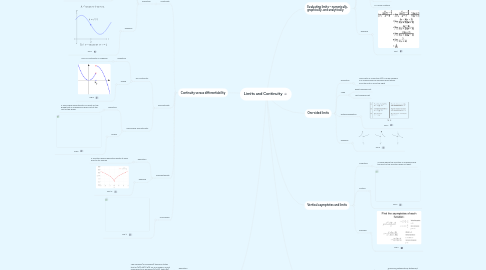
1. Continuity versus differentiability
1.1. Continuity
1.1.1. Definition
1.1.1.1. Uninterrupted connection, succession, or union
1.1.1.2. Requirements
1.1.1.2.1. Fig 6
1.1.1.3. Example
1.1.1.3.1. Fig 7
1.2. Discontinuity
1.2.1. Dis-continuity
1.2.1.1. Definition
1.2.1.1.1. Lack of continuity or cohesion
1.2.1.2. Graph
1.2.1.2.1. Fig 8
1.2.2. Removable Discontinuity
1.2.2.1. Definition
1.2.2.1.1. A removable discontinuity is a point on the graph that is undefined or does not fit the rest of the graph.
1.2.2.2. Graph
1.2.2.2.1. Fig 9
1.3. Differentiability
1.3.1. Definition
1.3.1.1. A function whose derivative exists at each point in its domain
1.3.2. Example
1.3.2.1. Fig 10
1.4. Conclusion
1.4.1. Fig 11
2. Squeeze Theorem
2.1. Definition
2.1.1. The squeeze (or sandwich) theorem states that if f(x)≤g(x)≤h(x) for all numbers, and at some point x=k we have f(k)=h(k), then g(k) must also be equal to them.
2.2. Equaution
2.2.1. f(x)≤g(x)≤h(x)
2.3. Graph
2.3.1. Fig 12
3. Evaluating limits – numerically, graphically, and analytically
3.1. Definition
3.1.1. Determine the value that the function is approaching at a certain point
3.2. Step
3.2.1. 1. Just Put The Value In
3.2.2. 2. Factors
3.2.3. 3. Conjugate
3.2.4. 4. Infinite Limits and Rational Functions
3.2.5. 5. L'Hôpital's Rule
3.2.6. 6. Formal Method
3.3. Example
3.3.1. Fig 1
4. One-sided limits
4.1. Definition
4.1.1. Two limits of a function f(x) of a real variable x as x approaches a specified point either from the left or from the right
4.2. Type
4.2.1. Right-handed limit
4.2.2. Left-handed limit
4.3. Detail Explanation
4.3.1. Fig 2
4.4. Example
4.4.1. Fig 3
5. Intermediate Value Theorem (IVT)
5.1. Definition
5.1.1. A precise mathematical statement (theorem) concerning the properties of continuous functions
5.2. Principle
5.2.1. A function is continuous on [a, b], and if L is any number between f(a) and f(b), then there must be a value, x = c, where a < c < b, such that f(c) = L
5.3. Graph
5.3.1. Fig 5
6. Vertical asymptotes and limits
6.1. Definition
6.1.1. A place where the function is undefined and the limit of the function does not exist.
6.2. Picture
6.2.1. Fig 3
6.3. Example
6.3.1. Fig 4
